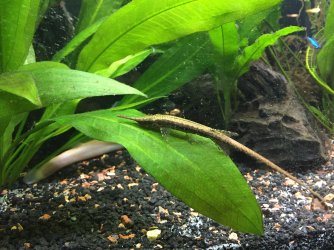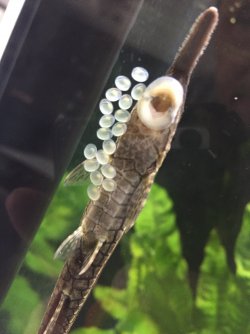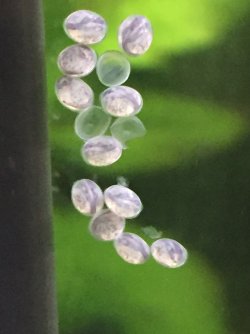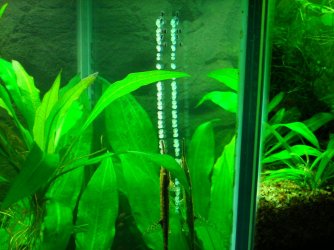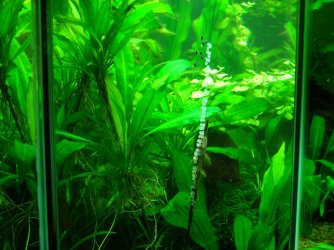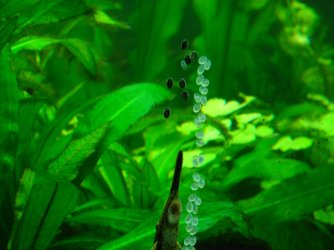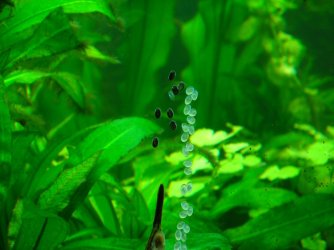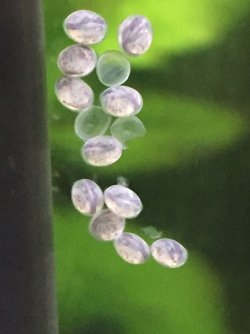I’m looking to see if anyone one here has had success with breeding farlowella catfish. I wasn’t planning on it, I knew I had a male and a female but I thought they were hard to spawn but I was wrong. I was planning on trying to rear the next batch of angels so I have a 10 gl tank setup and ready for growing them. I’ve been reading anything I can find online about taking care of the babies. One tip is to keep a supply of algae covered rocks and I just so happen to have a mature small garden pond with plenty of algae. I’m also going to soak spinach and kale for a few days and give that for food. The ph is 6.4 same as the main tank and temp is 80f with a sponge filter that has been cycled. Beyond this I’m going to do daily water changes and hope for the best. So far there are 18 but my reading suggests there could be more laid and the female is still fat with eggs, or so it seems. If anyone has any experience breeding these I really appreciate it. I believe they are F. vittata but I am not sure. Here are some pics
You are using an out of date browser. It may not display this or other websites correctly.
You should upgrade or use an alternative browser.
You should upgrade or use an alternative browser.
Breeding Farlowella catfish tips
- Thread starter stanleo
- Start date
We bred whiptails, royal whiptails and twig catfish years ago. They all breed the same way, lay eggs on smooth rocks, plant leaves or glass, ours always laid on the glass. Fry hatch after about a week if I recall correctly and the fry feed on biofilm on rocks and wood. They don't eat algae until they are a few weeks old. They need the bacteria in the biofilm to establish beneficial bacteria in their intestine so they can digest wood and plant matter when they get older.
Older well established tanks have a much higher success rate with the fry. Regular water changes and gravel cleans will keep the tank clean but don't clean ornaments, rocks or wood unless they have blue green algae (BGA) on them, because the BGA kills the fry.
If you have some rotting plant leaves in the tank that will help the fry. Amazon sword plants can have some of their leaves cut off and left to break down on the substrate for the young.
We didn't do anything special to get the fish to breed. They were well fed on a variety of frozen, live and dry foods, and we did regular water changes on the tank and the fish bred whenever they wanted to. Some of the foods we used included frozen but defrosted bloodworms, live daphnia and brineshrimp, various dry catfish pellets and algae wafers, and slices of cucumber, zucchini, pumpkin & carrot. Sometimes we blanched the fruit & veg and other times we used then crunchy and raw.
Older well established tanks have a much higher success rate with the fry. Regular water changes and gravel cleans will keep the tank clean but don't clean ornaments, rocks or wood unless they have blue green algae (BGA) on them, because the BGA kills the fry.
If you have some rotting plant leaves in the tank that will help the fry. Amazon sword plants can have some of their leaves cut off and left to break down on the substrate for the young.
We didn't do anything special to get the fish to breed. They were well fed on a variety of frozen, live and dry foods, and we did regular water changes on the tank and the fish bred whenever they wanted to. Some of the foods we used included frozen but defrosted bloodworms, live daphnia and brineshrimp, various dry catfish pellets and algae wafers, and slices of cucumber, zucchini, pumpkin & carrot. Sometimes we blanched the fruit & veg and other times we used then crunchy and raw.
There are so many fish in the main tank I fear that the babies will get eaten before they have a chance. The first batch of angels only lasted an hour after they were free swimming. Maybe there will be enough time for a film to grow in the grow up tank before I add the babies or I could transfer some of the small rocks with the babies. Thanks for the tips, very helpful.
You can't really transfer the fry because they are small and disappear when they hatch, and they can hatch any time. If the fish lay eggs on the glass you can't move them. However, if they lay eggs on a plant leaf or rock you can move that to a rearing tank just before they hatch. It's preferable to leave the parents with the eggs for as long as possible because they (normally the male but sometimes both) usually fan the eggs and look after them by mouthing over them to keep bacteria and other micro-organisms off the eggs.
If you plan on breeding any fish it's a good idea to prepare fry foods well before the fish breed. Same deal with the suckermouth catfish. Set up a rearing tank and put some plants and wood in it and leave it to run. You can put some mystery snails in the rearing tank to keep it running while there are no fry, but remove them when you put the eggs or fry in the tank. Or put the adult catfish in there and leave them in their own tank. Alternatively set it up as a plant and driftwood tank and nothing else but an airstone. Then move the eggs into it and put an established corner sponge filter in from another tank.
I always had a couple of air operated corner sponge filters running in my main tanks so they could be put into any tank if I had unplanned fry or fish that needed isolating.
If you plan on breeding any fish it's a good idea to prepare fry foods well before the fish breed. Same deal with the suckermouth catfish. Set up a rearing tank and put some plants and wood in it and leave it to run. You can put some mystery snails in the rearing tank to keep it running while there are no fry, but remove them when you put the eggs or fry in the tank. Or put the adult catfish in there and leave them in their own tank. Alternatively set it up as a plant and driftwood tank and nothing else but an airstone. Then move the eggs into it and put an established corner sponge filter in from another tank.
I always had a couple of air operated corner sponge filters running in my main tanks so they could be put into any tank if I had unplanned fry or fish that needed isolating.
Just an idea, but what if you somehow put either thin sheets of plexiglass against the glass of the tank, or perhaps even some kind of plastic wrap if you could get it to stick/weigh it down, so if they lay eggs on the tank walls you could still transfer the eggs to the fry tank when they are close to hatching? No idea if it would work or be practical but I just thunk that up haha.
I have raised several spawnings of Farlowella vitatta quite easily. The one thing I would add to what has already been mentioned is to have dried leaves handy; oak is what I used, which I collect in the rear garden every autumn and use in various tanks for décor, but it is ideal for infusoria; fry in tanks with dried leaves develop faster than without.
I left the eggs on the glass; the male is very thorough at protecting them. Mine tend to take 12-14 days to hatch. When they do, the fry hang on the glass or leaves for another 5-6 days before they become free swimming. When I want to save fry (my parent pair spawns three or four times a year) I wait until they begin to hatch which in my case has always been early morning, then I carefully net the fry off the glass or plant leaves. You could move the plant leaves (break them off) if you want. I use my 10g tank which has a group of pygmy cories that spawn regularly; they won't eat each other, but the fry during the yolk sac stage are vulnerable to most other fish. I move them into the 10g, add several dried leaves, and away they go. Not all of them survive, and I am OK with that. Getting rid of the fry is not that easy, here anyway. I find them very slow growing, but that may be due to food. But they very quickly learn to feed from Omega One Veggie Rounds.
I left the eggs on the glass; the male is very thorough at protecting them. Mine tend to take 12-14 days to hatch. When they do, the fry hang on the glass or leaves for another 5-6 days before they become free swimming. When I want to save fry (my parent pair spawns three or four times a year) I wait until they begin to hatch which in my case has always been early morning, then I carefully net the fry off the glass or plant leaves. You could move the plant leaves (break them off) if you want. I use my 10g tank which has a group of pygmy cories that spawn regularly; they won't eat each other, but the fry during the yolk sac stage are vulnerable to most other fish. I move them into the 10g, add several dried leaves, and away they go. Not all of them survive, and I am OK with that. Getting rid of the fry is not that easy, here anyway. I find them very slow growing, but that may be due to food. But they very quickly learn to feed from Omega One Veggie Rounds.
7 eggs went bad but I still have 11 viable eggs and I can see the babies moving inside them which I think is pretty cool. Took this pic today, anyone venture a guess how long till they hatch?
If it has been five or six days since laying, you are not quite half way there. Mine take 10-14 days. And they get completely black, from the fry inside.
They were layed last Thursday night so yeah about 6 days, thanks for that Byron. And they get completely black that’s helpful.
I do have another question. I usually do my water change On Friday morning and I do half the volume. The trouble is the eggs are well above the level the water will go to during the change. If I do it the normal way the eggs will be above the water for about 15 minutes. Is that safe? If not I thought I could do the change to a level where the eggs will just be below the surface, about 15 gallons on a 120 gallons tank and I could do that daily till I get to the volume of my normal water change. Does that sound right?
I do have another question. I usually do my water change On Friday morning and I do half the volume. The trouble is the eggs are well above the level the water will go to during the change. If I do it the normal way the eggs will be above the water for about 15 minutes. Is that safe? If not I thought I could do the change to a level where the eggs will just be below the surface, about 15 gallons on a 120 gallons tank and I could do that daily till I get to the volume of my normal water change. Does that sound right?
They were layed last Thursday night so yeah about 6 days, thanks for that Byron. And they get completely black that’s helpful.
I do have another question. I usually do my water change On Friday morning and I do half the volume. The trouble is the eggs are well above the level the water will go to during the change. If I do it the normal way the eggs will be above the water for about 15 minutes. Is that safe? If not I thought I could do the change to a level where the eggs will just be below the surface, about 15 gallons on a 120 gallons tank and I could do that daily till I get to the volume of my normal water change. Does that sound right?
My pair have spawned many times, and I do the water change normally, leaving the eggs on the glass when the water lowers. The male guarding them always scampers down as soon as I begin, but he returns afterwards. During the low level, I tend to splash the eggs with a handful of water a couple times, if I remember. I have never had a clutch fail to hatch doing this, and pretty much every time there have been two water changes while the eggs were being guarded since they take up to a week. So given the benefit of larger changes over smaller even if more frequent, I would continue as usual.
I found some photos of the eggs that show the black ones and the newer white/clear eggs. This was back when I had a trio of adults acquired in the autumn of 2008, that turned out to be two females and a male. As is common, the male will spawn with both females (if they are ready) and the eggs are laid in the same area so he can guard both spawns. My trio did this a few times over three years when one of the females suddenly died for reasons unknown. The remaining pair have spawned repeatedly since. You can see the older spawn as the black eggs near the top; the two parallel rows are the second spawn with the other female. This was the spawn in July 2009.
Attachments
Those pics make me jealous that I only got 18 eggs.
I did the normal water change the morning after they were layed and didn’t see the eggs until they were out of the water and they seemed to survive though I am worried that that could be the reason that 7 of them went bad.
I did the normal water change the morning after they were layed and didn’t see the eggs until they were out of the water and they seemed to survive though I am worried that that could be the reason that 7 of them went bad.
Those pics make me jealous that I only got 18 eggs.
I did the normal water change the morning after they were layed and didn’t see the eggs until they were out of the water and they seemed to survive though I am worried that that could be the reason that 7 of them went bad.
What do you mean by "went bad?"
When I first looked at them they all seemed viable and then three days later (I work the entire time the lights are on Saturday and Sunday) on Monday 7 of them were milky white or gone. The shells were gone on a few of them like in this pic.
Attachments
Similar threads
- Replies
- 4
- Views
- 689
- Replies
- 2
- Views
- 304

